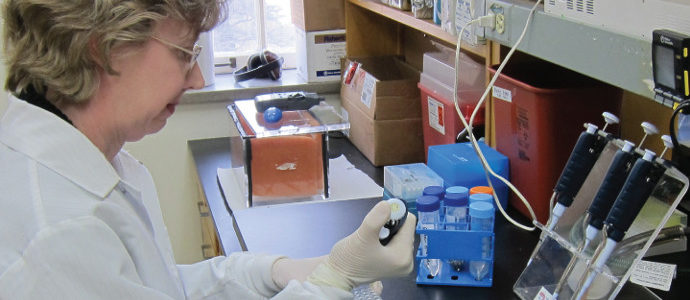The 18th International Fragile X and Related Neurodevelopmental Disorders Workshop in Quebec, Canada, was a great success, featuring Fragile X much more heavily than any previous meeting in this series! We asked our speakers to summarize their work in their own words, with brief updates from researchers investigating Fragile X.
Read moremRNAs
Targeted Transcriptional Reactivation of FMR1 in Fragile X Syndrome Stem Cells

With a $90,000 grant from FRAXA Research Foundation awarded in 2016, University of Michigan researcher Peter Todd, MD, PhD, is using CRISPR to selectively turn the Fragile X gene back on in stem cells.
Read moreFragile X Nervous (System) Breakdown

“The occurrence and development of events by chance in a happy or beneficial way.” That’s how Lynne E. Maquat, PhD, describes the process of how her research extended to Fragile X syndrome to better understand it and ultimately find advanced treatments.
Read moreFunction of FMRP and Test of a Novel Therapeutic Approach in a Fragile X Mouse Model

With a 2015-2016 $90,000 grant from FRAXA Research Foundation, Dr. Herve Moine and Dr. Andrea Geoffroy aim to uncover the exact role of FMRP and to test a novel possible means to correct for FMRP absence in the mouse model of Fragile X syndrome.
Read moreFragile X Mutant Mouse Models

With $375,000 in grants from the FRAXA Research Foundation since 2009, Dr. David Nelson has developed an impressive array of advanced mouse models of Fragile X, at Baylor College of Medicine. These models are available to investigators worldwide on request. This resource has been essential for a broad, rapid distribution of Fragile X and related gene mouse models and has increased the pace of Fragile X research.
Read moreRepurposing Drugs to Dampen Hyperactive Nonsense-Mediated Decay in Fragile X Syndrome

With a $90,000 grant from the FRAXA Research Foundation, Dr. Lynne Maquat and Dr. Tatsuaki Kurosaki will investigate nonsense-mediated mRNA decay (NMD) in Fragile X. NMD is a “housekeeping” process that cells use to prevent faulty proteins from being made. But there is too much of it in Fragile X syndrome. There are already available drugs that suppress NMD – including caffeine.
Read moreBoston Bruins Grant Funds New Fragile X Research

Bruins Foundation Executive Director Bob Sweeney pledging a $90,000 donation to FRAXA Research today at Shared Living Collaborative’s Gateway Farm in Merrimac, MA. The award will enable the organization to fund an entirely new research project aimed at developing new treatments for Fragile X, a genetic syndrome that is the most common inherited cause of autism.
Read moreFRAXA Grant to Nahum Sonenberg, PhD — Effects of metformin in Fmr1 knockout mouse model of Fragile X syndrome

Mis-regulation of activity-dependent protein synthesis is one of the major cellular abnormalities found in Fragile X. Upstream neuronal signaling regulates a large cluster of enzymes called the mTORC1 complex, which in turn regulates protein synthesis. This complex is also controlled by cellular energy levels via the metabolic sensor AMP-activated Protein Kinase (AMPK). AMPK is a highly conserved kinase that is activated under conditions of energy stress, when intracellular ATP levels decline and intracellular AMP increases.
Read moreInhibitors of STEP as a Novel Treatment of Fragile X Syndrome

With a $349,000 grant from FRAXA Research Foundation from 2008-2015, Dr. Paul Lombroso and his team at Yale University researched if inhibiting STEP could reduce behavioral abnormalities in Fragile X syndrome. Results published.
Read moreMolecular Mechanisms of Cytoskeletal Regulation by FMRP

With a 2-year, $120,000 grant from FRAXA Research Foundation in 2015, Dr. Samie Jaffrey from Weill Medical College of Cornell University will research the connection between FMR1, RhoA, and dendritic spine abnormalities.
Read moreFunctional Interplay Between FMRP and CDK5 Signaling
With a $180,000 grant from the FRAXA Research Foundation over 2011-2014, Dr. Yue Feng and Dr. Wenqi Li at Emory University will study CDK5 pathway function and regulation in an effort to break down whether and how CDK5 signaling is affected by the loss of the Fragile X protein, FMRP, in the Fragile X mouse model.
Read moreScientists Uncover Trigger for Fragile X Syndrome

A new study led by Weill Cornell Medical College scientists shows that Fragile X syndrome occurs because of a mechanism that shuts off the gene associated with the disease. The findings, published today in Science, also show that a compound that blocks this silencing mechanism can prevent Fragile X syndrome – suggesting a similar therapy may be possible for 20 other diseases that range from mental retardation to multisystem failure.
Read moreSmall Molecules To Target r(CGG) Expansions to Treat Fragile X Syndrome

With a 2-year, $90,000 grant from FRAXA Research Foundation, Dr.’s Matthew Disney and Wang-Yong Yang worked to correct the underlying problem in Fragile X: the silencing of the Fragile X gene (FMR1) and the resulting lack of FMRP (Fragile X Mental Retardation Protein). Their approach was to use novel small molecules to target the abnormal CGG repeats before the FMR1 gene.
Read moreFragile X Syndrome Protein Linked to Breast Cancer Progression
Claudia Bagni (VIB/KU Leuven, Belgium, and the University of Rome, Italy) and colleagues have identified the way Fragile X Mental Retardation Protein or FMRP contributes to the progression of breast cancer. The researchers demonstrated that FMRP acts as a master switch controlling the levels of several proteins involved in different stages of aggressive breast cancer, including the invasion of cancer cells into blood vessels and the spread of these cancer cells to other tissues forming metastasis.
Read moreAb-Mediated Translation in Fragile X Syndrome

With a $120,000 grant from FRAXA Research Foundation during 2011-2012, Dr. Cara Westmark at the University of Wisconsin explored the role of AbPP as a potential treatment option for fragile X. AbPP produces b-amyloid which is over-expressed in Alzheimer’s disease (AD) and Down syndrome.
Read moreSynaptic Actin Signaling Pathways in Fragile X

With a $163,356 grant from FRAXA Research Foundation in 2010-12, Dr. Scott Soderling and Dr. Hwan Kim at Duke University bred the standard mouse model of Fragile X syndrome to their lines of mice that express reduced levels of several key proteins that modulate synaptic actin. These compound mutant mice were compared to FXS mice to determine if genetically impairing pathways to the actin cytoskeleton can rescue deficits in the FXS mice.
Read moreGenetic and Pharmacologic Manipulation of PI3K Activity in FXS: Assessing Potential Therapeutic Value

With a $90,000 grant from the FRAXA Research Foundation, Dr. Gary Bassell and his team at Emory University explored the PI3K/mTOR signaling complex in FXS via genetic and pharmacologic rescue approaches, to reduce the enzymatic function of specific components of this complex pathway in an FXS mouse model.
Read moreInherited Channelopathies in Cortical Circuits of Fmr1 KO Mice

With this two year award of $90,000, Dr. Zhang and Principal Investigator Dr. Andreas Frick at Neurocentre Magendie in France investigated channelopathies using Fragile X mice. Many other proteins are misregulated as a result of the absence of FMRP. It is known that many ion channels, the pores in the cell membrane which allow neurons to conduct electrical impulses, have altered levels in Fragile X. This state is sometime called a “channelopathy” in the pharma world. This group is studying the effect of specific alterations in ion channels, and potential therapeutic effects of drugs which open and close these channels.
Read moreRole of JNK in FMRP Regulated Translation in Fragile X Syndrome

With a $90,000 grant from FRAXA Research Foundation over 2 years, Dr. Michael Wilhelm and his team at the University of Wisconsin studied a protein known as JNK, which is observed to be abnormally regulated in Fragile X. Like FMRP, it is involved in regulating dendritic protein synthesis, and so it may be a target for drug therapy in Fragile X.
Read moreRole of Excessive Protein Synthesis in the Ontogeny of FXS

With a $90,000 grant from FRAXA Research Foundation in 2010-2011, Dr. Mark Bear and Dr. Miquel Bosch tested the simple hypothesis that the excessive rate of protein synthesis is not a consequence but the primary cause of the structural alterations occurring in Fragile X syndrome.
Read moreAltered Dendritic Synthesis of Postsynaptic Scaffold Protein Shank1 in Fragile X Syndrome

With a $106,800 grant from FRAXA Research Foundation over 2 years, Drs. Stephan Kindler and Hans-Jurgen Kreieinkamp studied a protein, Shank1, which is overabundant in Fragile X syndrome.
Read moreThe Slack Potassium Ion channel is a Therapeutic Target for Fragile X

With $282,000 in funding from FRAXA Research Foundation, Dr. Leonard Kaczmarek and colleagues explored association of Slack channels with the Fragile X protein (FMRP).
Read moreComposition and Localization of Dendritic mRNAs in Fragile X Syndrome
With a $80,000 grant from FRAXA Research Foundation over 2 years, Drs. Smith and Wang are investigating which proteins, as well as the mRNA’s that code those proteins, are dysregulated in Fragile X. They have developed a elegant system to visualize the proteins and mRNA’s and determine where they are spacially in the neuron. This will help to better understand the root causes of Fragile X syndrome and to design targeted treatments.
Read moreBasic Mechanisms of Disease and Potential Therapeutic Strategies

With $245,000 in grants from FRAXA Research Foundation, Dr. Stephen Warren and his lab at Emory University studied all aspects of Fragile X syndrome, from the mechanisms of repeat expansion to high-throughput drug screens in the Drosophila model of Fragile X. The Warren lab made the original discovery of the Fragile X gene, FMR1, in collaboration with the Nelson and Oostra labs, and is recognized internationally as a leader in molecular genetics. Recent projects include establishment of induced pluripotent stem cell lines from Fragile X patients, and determination of other forms of mutation in the Fragile X gene, other than the most common trinucleotide repeat expansion.
Read moreRole of FMRP in the Regulation of Synaptic Plasticity

With more than $1,000,000 from FRAXA Research Foundation over 13 years, Drs. William Greenough and Ivan-Jeanne Weiler at the University of Illinois uncovered the role of FMRP at synapses, leading to much of the subsequent research on Fragile X syndrome.
Read more
